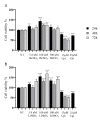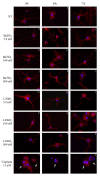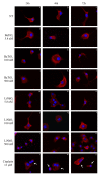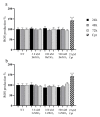Neuron Compatibility and Antioxidant Activity of Barium Titanate and Lithium Niobate Nanoparticles
- PMID: 35163681
- PMCID: PMC8836423
- DOI: 10.3390/ijms23031761
Neuron Compatibility and Antioxidant Activity of Barium Titanate and Lithium Niobate Nanoparticles
Abstract
The biocompatibility and the antioxidant activity of barium titanate (BaTiO3) and lithium niobate (LiNbO3) were investigated on a neuronal cell line, the PC12, to explore the possibility of using piezoelectric nanoparticles in the treatment of inner ear diseases, avoiding damage to neurons, the most delicate and sensitive human cells. The cytocompatibility of the compounds was verified by analysing cell viability, cell morphology, apoptotic markers, oxidative stress and neurite outgrowth. The results showed that BaTiO3 and LiNbO3 nanoparticles do not affect the viability, morphological features, cytochrome c distribution and production of reactive oxygen species (ROS) by PC12 cells, and stimulate neurite branching. These data suggest the biocompatibility of BaTiO3 and LiNbO3 nanoparticles, and that they could be suitable candidates to improve the efficiency of new implantable hearing devices without damaging the neuronal cells.
Keywords: PC12; ROS; apoptosis; neuronal cell line; oxidative stress; piezoelectric material.
Conflict of interest statement
The authors declare no conflict of interest. The funders had no role in the design of the study; in the collection, analyses, or interpretation of data; in the writing of the manuscript, or in the decision to publish the results.
Figures





Similar articles
-
Piezoelectric Nanoparticle-Based Ultrasound Wireless Piezoelectric Neuromodulation Inhibits Epileptiform Activity of Primary Neurons.ACS Appl Bio Mater. 2024 Dec 16;7(12):8543-8551. doi: 10.1021/acsabm.4c01343. Epub 2024 Nov 18. ACS Appl Bio Mater. 2024. PMID: 39556669
-
Polydimethylsiloxanes biocompatibility in PC12 neuronal cell line.Colloids Surf B Biointerfaces. 2019 Jan 1;173:400-406. doi: 10.1016/j.colsurfb.2018.10.005. Epub 2018 Oct 6. Colloids Surf B Biointerfaces. 2019. PMID: 30321797
-
Preparation of stable dispersion of barium titanate nanoparticles: Potential applications in biomedicine.Colloids Surf B Biointerfaces. 2010 Apr 1;76(2):535-43. doi: 10.1016/j.colsurfb.2009.12.015. Epub 2009 Dec 24. Colloids Surf B Biointerfaces. 2010. PMID: 20060274
-
Biocompatibility and osteogenesis of the castor bean polymer doped with silica (SiO2) or barium titanate (BaTiO3) nanoparticles.Acta Cir Bras. 2015 Apr;30(4):255-63. doi: 10.1590/S0102-865020150040000004. Epub 2015 Apr 1. Acta Cir Bras. 2015. PMID: 25923258
-
A Comprehensive Review on Barium Titanate Nanoparticles as a Persuasive Piezoelectric Material for Biomedical Applications: Prospects and Challenges.Small. 2023 Mar;19(12):e2206401. doi: 10.1002/smll.202206401. Epub 2022 Dec 30. Small. 2023. PMID: 36585372 Review.
Cited by
-
Bifunctional MXene-Augmented Retinal Progenitor Cell Transplantation for Retinal Degeneration.Adv Sci (Weinh). 2023 Sep;10(25):e2302747. doi: 10.1002/advs.202302747. Epub 2023 Jun 28. Adv Sci (Weinh). 2023. PMID: 37379237 Free PMC article.
-
Revolutionizing neural regeneration with smart responsive materials: Current insights and future prospects.Bioact Mater. 2025 Jun 13;52:393-421. doi: 10.1016/j.bioactmat.2025.06.003. eCollection 2025 Oct. Bioact Mater. 2025. PMID: 40585385 Free PMC article. Review.
-
Nanomaterials for Inner Ear Diseases: Challenges, Limitations and Opportunities.Materials (Basel). 2022 May 25;15(11):3780. doi: 10.3390/ma15113780. Materials (Basel). 2022. PMID: 35683076 Free PMC article. Review.
-
Advanced development of conductive biomaterials for enhanced peripheral nerve regeneration: a review.RSC Adv. 2025 Apr 22;15(17):12997-13009. doi: 10.1039/d5ra01107h. eCollection 2025 Apr 22. RSC Adv. 2025. PMID: 40271417 Free PMC article. Review.
-
Multi-Parametric Exploration of a Selection of Piezoceramic Materials for Bone Graft Substitute Applications.Materials (Basel). 2023 Jan 17;16(3):901. doi: 10.3390/ma16030901. Materials (Basel). 2023. PMID: 36769908 Free PMC article.
References
-
- Astolfi L., Danti S. Stem cells and nanotechnology. In: Hatzopoulos S., Ciorba A., Krumm M., editors. Advances in Audiology and Hearing Science. Volume 2: Otoprotection, Regeneration, and Telemedicine. Apple Academic Press; Palm Bay, FL, USA: 2020. pp. 271–300. - DOI
-
- Wang G. Nanotechnology: The New Feature. Cornell University; Ithaca, NY, USA: 2018.
-
- Elsayed M.A., Norredin A. The Potential Contribution of Nanoparticles in the Treatment of Inflammatory Diseases. In: Nunes A.C.F., editor. Translational Studies on Inflammation. IntechOpen; London, UK: 2019. - DOI
MeSH terms
Substances
LinkOut - more resources
Full Text Sources
Medical

